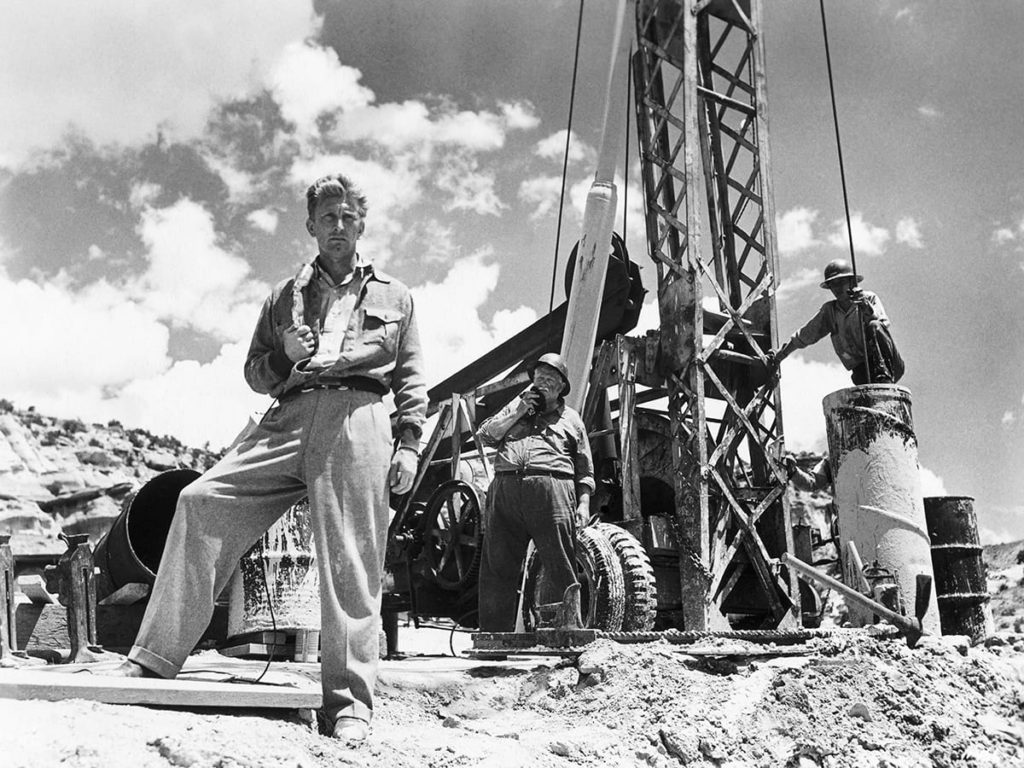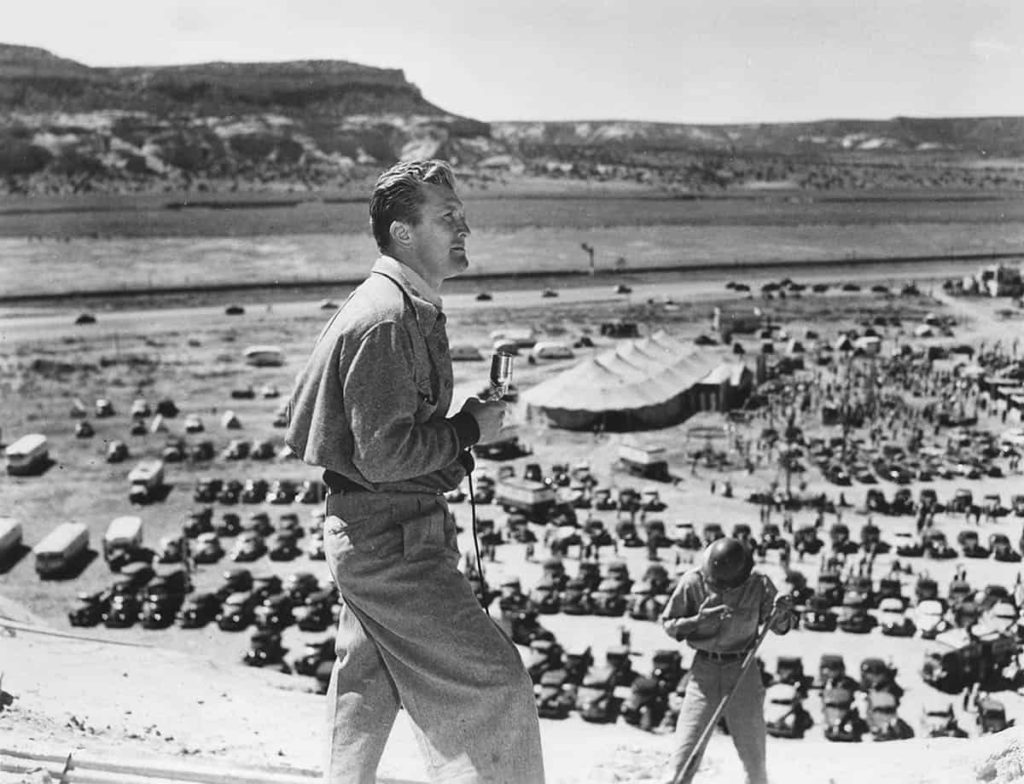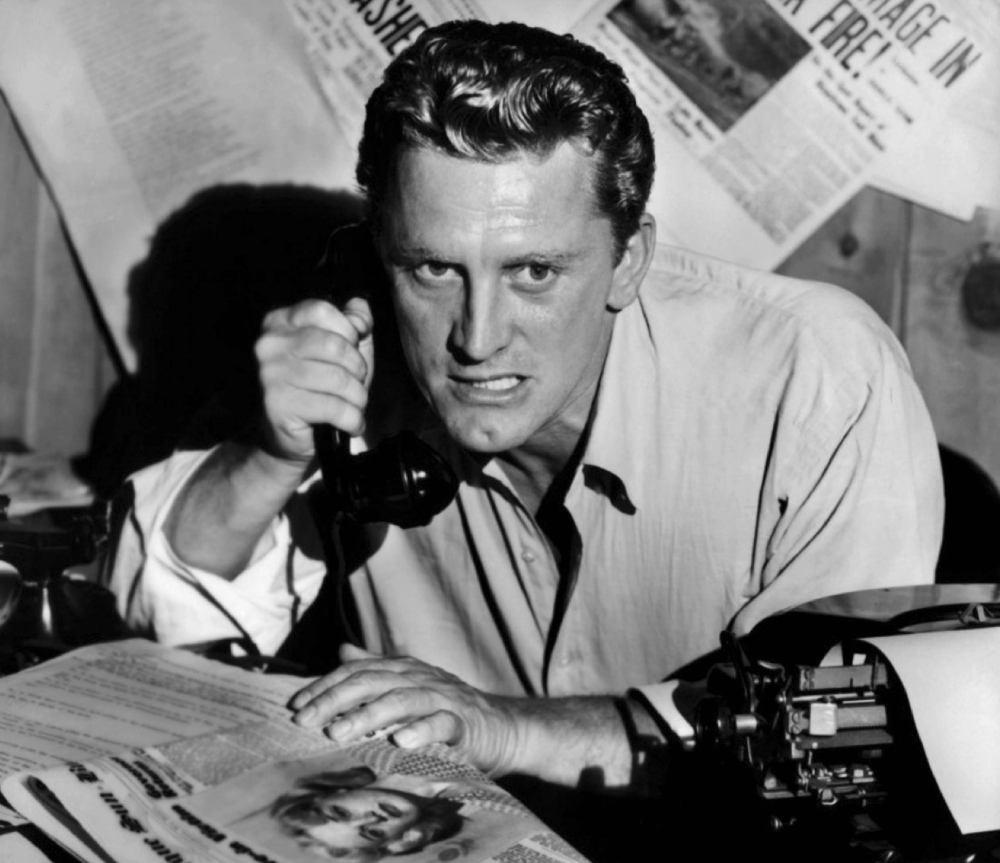Attend: Program Notes
Ace in the Hole | Billy Wilder | United States | 1951 | 111 min.
Cinesthesia, Madison Public Library Central Branch, Wednesday, July 3, 6:30 p.m.»
A hard-hitting exposé of the perpetual American media circus, Billy Wilder’s Ace in the Hole is dark for 2019, let alone 1951.
WARNING: CONTAINS SPOILERS.
One of the most nihilistic, hard-edged, and brutally honest pictures to ever come out of the Hollywood studio system, Billy Wilder’s Ace in the Hole exposes the underbelly of American media culture, while fearlessly investigating the corrosive effects of sensationalized news on society and the individual soul.
Kirk Douglas stars as Chuck Tatum, a cynical, profligate, and fiercely ambitious journalist who takes a job at a dreary newspaper office in the middle of the New Mexico desert. Once a successful reporter, he has been dismissed from eleven metropolitan newspapers for reasons including drunkenness, slander, and adultery. After a year of tedium working for the Albuquerque Sun-Bulletin, Tatum stumbles upon a story that will return him to prominence. Dispatched to the outskirts of town to cover a rattlesnake hunt, he and an impressionable young photographer, Herbie Cook (Bob Arthur), stop at a remote trading post for gas and presently discover that the proprietor, Leo Minosa (Richard Benedict), has been trapped in an abandoned silver mine by a cave-in. Tatum then does everything in his power to manipulate the scoop into a sensational public event, even conspiring with the corrupt local sheriff (Ray Teal) to prolong the ordeal and exploit it for headlines. In no time, the effort to rescue Minosa becomes a lurid, exaggerated spectacle as tourists, politicians, reporters, and various performers all converge on the site for their own dubious purposes. While Ace in the Hole was a commercial and critical failure upon its release, Wilder’s biting, prescient satire of the American media feels especially up-to-the-minute in our post-truth world.

Initially titled The Human Interest Story, Ace in the Hole was inspired by real-life events. In January 1925, Floyd Collins, the owner of the Crystal Cave in central Kentucky, became trapped inside after a landslide.A young Louisville reporter, William Burke “Skeets” Miller, helped direct the rescue operation, covering the story all the while. Collins’ misfortune thus became America’s entertainment. As in Wilder’s film, the story gained national attention and a carnivalesque atmosphere sprang up outside the cave. Collins died fifteen days into the rescue and Miller was awarded the Pulitzer Prize for his articles. Roaring Twenties readers never tired of the sordid details, especially when certain irregularities began to emerge. One of the supposed rescuers lied about having reached Collins with food; items meant for Collins were found tucked into niches in the cave wall. A man claiming to be Floyd Collins turned up in Kansas one week into the rescue operation. (He was not Collins.) Finally, Floyd’s brother Homer, who determinedly and heroically attempted to aid his brother during the crisis, announced upon Floyd’s death that he was putting a road show together to tell his own version of the tragedy for anyone willing to buy a ticket.
The case of Kathy Fiscus, both sadder and more farcical, has also been cited as an influence on the film. In April 1949, in the Los Angeles suburb of San Marino, a three-year-old girl fell into an abandoned well and launched a national media sensation. Television reporters broadcast live stories on the rescue effort and several thousand spectators showed up to watch the excitement unfold. Cave-ins and seeping water delayed the operation, which involved klieg lights donated by Hollywood studios, power drills, earth movers, and a host of engineers, miners, and cesspool experts. Jockeys from the Santa Anita racetrack arrived and volunteered to be lowered into the well. Johnny Roventini, the Philip Morris cigarette dwarf, appeared, too, as did an earnest contingent of diminutive clowns from the Cole Bros. Circus. When the rescuers finally reached her, Kathy Fiscus was dead, and the disappointed crowds promptly dispersed.
Ace in the Hole was the first Hollywood film that Wilder did not co-write with his longtime collaborator, Charles Brackett, a conservative Republican and ex-New Yorker drama critic who clashed creatively with him. The idea for the story was presented to Wilder in the form of a treatment by radio writer Walter Newman. Playwright Lesser Samuels was brought in for polish. Wilder, Newman, and Samuels worked on the script (which was nominated for an Academy Award) throughout the spring and summer of 1950.
An early draft of the screenplay reportedly included voice-over narration by Tatum as his corpse is being loaded onto a railway baggage car. Wilder also toyed with the idea of making Lorraine (Jan Sterling), the jaded, world-weary wife of Leo, even more avaricious, having her beg Tatum not to reveal her husband’s death so the circus could run one more weekend. In one version, Lorraine is run over by a carnival truck.
On July 6, 1950, just four days before the beginning of principal photography, the shooting script was finished. Wilder sent a copy to Joseph Breen at the Production Code office, who responded that the script was lacking “a proper voice for morality” at the end. He was especially concerned about the wider social implications of presenting a corrupt law enforcement officer on American movie screens. Because Tatum ultimately pays for his transgressions with his life, Breen was relatively easy on Ace in the Hole.
But Breen and his advisers believed that “Sheriff [Gus] Kretzer breezes out of the story a little too easily, considering the malice of his misdeeds throughout the story.” The censor expected Wilder to develop some additional dialogue, “which will make it clear that Kretzer will be answerable for his evil in the near future.” In the finished film, Tatum declares that he plans to write some sort of exposé about the sheriff.

Ace in the Hole was shot in forty-five days and cost approximately $1,842,000 to produce. Location filming took place in Albuquerque and in an area outside of Gallup, New Mexico, where Paramount’s advance team had prepared the ancient cliff dwelling, parking lot, and trading post. The term “media circus” was not yet in use when Wilder shot the enormous carnival that arises around the plight of Leo Minosa. An entire day was set aside purely for rehearsal; the circus was filmed on what Paramount’s public relations team claimed was the largest noncombat set ever constructed. The set—235 feet high, 1,200 feet across, and 1,600 feet deep—included the cliff, roadside stands, amusement rides, a parking lot for 500 cars, booths, concession stands, and musicians. Over a thousand locals were hired as extras.
When Ace in the Hole premiered at New York’s Globe Theatre on June 30, 1951, the film flopped with a resounding thud. Although it won a Golden Lion at the 1951 Venice Film Festival and was a hit with the British press, critical reaction in the U.S. was mixed. John McCarten in the The New Yorker deemed the film “a compound of unjelled satire, half-baked melodrama, and dialogue in which not even a dowsing rod could discover a vein of wit,” and called Chuck Tatum “certainly the most preposterous version of a reporter I’ve ever seen.” Bosley Crowther labeled it “one of the truly challenging pictures of this year,” and praised Wilder’s “spectacular job of visioning the monstrous vulgarity of mob behavior.” However, the New York Times critic took exception to what he described as a “distortion of journalistic practice.”The Hollywood Reporter’s reviewer called Ace in the Hole “a brazen, uncalled-for slap in the face of two respected and frequently effective American institutions—democratic government and the free press.”
The American press made such an outcry against the film that Y. Frank Freeman, who was vice president at Paramount, dispatched publicity agents to city desks around the country to explain that “the picture’s depiction of trashy journalism was not directed against the Fourth Estate as such,” but only against a few bad apples. In an effort to revive the movie’s chances of finding an audience in the United States, Freeman retitled it The Big Carnival and reissued it in the domestic market. Freeman made this decision without Wilder’s knowledge or consent; the director was so incensed that he began to consider leaving Paramount forever. In any case, the film did not go well with the alternate title and it was changed back.

With its vérité photography, its razor-sharp dialogue, its savage indictment of tabloid journalism, and its uncompromisingly bleak outlook on American life, Ace in the Hole is dark for 2019, let alone 1951. The movie has become increasingly relevant as the excesses of the press and public become more flagrant. (Director Spike Lee, who allegedly wanted to remake Ace in the Hole, copied the last shot of the picture in his 1992 film Malcolm X.) In Wilder’s searing portrait of the perpetual media circus, the targets of his attack are not only the unscrupulous reporter who covers the story or the victim’s shameless wife, but also the mass of faceless, anonymous, passive spectators who have an insatiable appetite for sensation.
In a 2014 essay on Wilder’s film titled Ace in the Hole: Noir in Broad Daylight, critic Molly Haskell writes:
Wilder’s vision of corruption seems to take in the whole spectrum of grubby, postwar America, with its loss of moral imperatives, its return to normalcy after the excitement of the war years. He plants his finger firmly and prophetically on the pulse of the new excitement, an addiction to the breaking story that television would create and feed to a nation of adrenaline junkies. Already in the squawking, hawking opportunists are our own telegenic communicators in embryonic form, the self-promoting reporters donning Bedouin robes or Muslim chadors or hurricane slickers to provide twenty-four-hour coverage of themselves at the ego-center of hot spots and sleazy “human interest” tabloid stories. Stories whose staying power is manufactured, stories stretched out beyond any “human interest” at all, simply because they are scary, scandalous, sordid, or just bad, and fill the airspace until the next bad story arrives—or until the anniversary of an old one.
In a conversation with Charlotte Chandler published in her 2002 book Nobody’s Perfect: Billy Wilder, A Personal Biography, the director discusses his favorite film and the unpalatability of its bitter realism.
“Ace in the Hole was a failure here, but a success in Europe. I think my mistake was in offering the American public a shot of vinegar when they thought they were going to get a nice cocktail. It was a vinegar cocktail. The reviewers said I was too cynical, that no newspaperman would really act that way.”
Shortly after the film was blasted by the press, Wilder recalls, “I was feeling very downhearted, walking down Wilshire Boulevard when, right in front of me, somebody got hit by a car. A cameraman comes running up out of nowhere. I said, ‘We’ve got to help him.’ The cameraman said, ‘You help him. I’ve gotta get my picture in.’ And off the guy went. Maybe I wasn’t cynical enough when I did Ace in the Hole.”